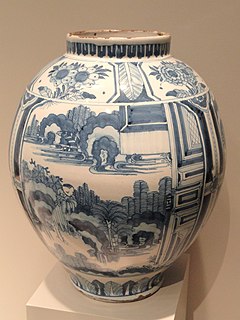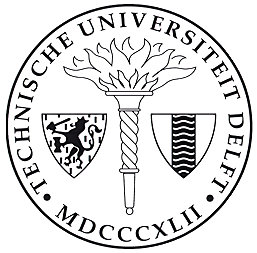
The Delft Bible (1477) is the first substantial Dutch Bible translation to be printed. [1] It did not include the New Testament or the Psalms, which were already available in separate editions.

The Delft Bible (1477) is the first substantial Dutch Bible translation to be printed. [1] It did not include the New Testament or the Psalms, which were already available in separate editions.

The Bible is a collection of religious texts or scriptures sacred in Christianity, Judaism, Samaritanism, and many other religions. The Bible is an anthology—a compilation of texts of a variety of forms—originally written in Hebrew, Aramaic, and Koine Greek. These texts include instructions, stories, poetry, and prophesies, among other genres. The collection of materials that are accepted as part of the Bible by a particular religious tradition or community is called a biblical canon. Believers in the Bible generally consider it to be a product of divine inspiration, while understanding what that means in different ways.

Delft is a city and municipality in the province of South Holland, Netherlands. It is located between Rotterdam, to the southeast, and The Hague, to the northwest. Together with them, it is part of both Rotterdam–The Hague metropolitan area and the Randstad.

Antonie Philips van Leeuwenhoek was a Dutch businessman and scientist in the Golden Age of Dutch science and technology. A largely self-taught man in science, he is commonly known as "the Father of Microbiology", and one of the first microscopists and microbiologists. Van Leeuwenhoek is best known for his pioneering work in microscopy and for his contributions toward the establishment of microbiology as a scientific discipline.

Johannes Vermeer was a Dutch Baroque Period painter who specialized in domestic interior scenes of middle-class life. During his lifetime, he was a moderately successful provincial genre painter, recognized in Delft and The Hague. Nonetheless, he produced relatively few paintings and evidently was not wealthy, leaving his wife and children in debt at his death.

Delftware or Delft pottery, also known as Delft Blue, is a general term now used for Dutch tin-glazed earthenware, a form of faience. Most of it is blue and white pottery, and the city of Delft in the Netherlands was the major centre of production, but the term covers wares with other colours, and made elsewhere. It is also used for similar pottery, English delftware.

Delft University of Technology, also known as TU Delft, is the oldest and largest Dutch public technical university, located in Delft, Netherlands. As of 2022 it is ranked by QS World University Rankings among the top 10 engineering and technology universities in the world.

Carel Pietersz. Fabritius was a Dutch painter. He was a pupil of Rembrandt and worked in his studio in Amsterdam. Fabritius, who was a member of the Delft School, developed his own artistic style and experimented with perspective and lighting. Among his works are A View of Delft, The Goldfinch (1654), and The Sentry (1654).

Delfshaven is a borough of Rotterdam, Netherlands, on the right bank of river Nieuwe Maas. It was a separate municipality until 1886.

The Nieuwe Kerk is a Protestant church in the city of Delft in the Netherlands. The building is located on Delft Market Square (Markt), opposite to the City Hall. In 1584, William the Silent was entombed here in a mausoleum designed by Hendrick and Pieter de Keyser. Since then members of the House of Orange-Nassau have been entombed in the royal crypt. The latest are Queen Juliana and her husband Prince Bernhard in 2004. The private royal family crypt is not open to the public. The church tower, designed by Pierre Cuypers and completed in 1872, is the second highest in the Netherlands, after the Domtoren in Utrecht.

The Delft School is a category of mid-17th-century Dutch Golden Age painting named after its main base, Delft. It is best known for genre painting: images of domestic life, views of households, church interiors, courtyards, squares and the streets of that city. Carel Fabritius and Nicolaes Maes are seen as the originators of these localised specialties in the 1640s that were continued in the 1650s by Pieter de Hooch and Johannes Vermeer. Vermeer is the most famous of these painters today. The architectural interiors of Gerard Houckgeest, Emanuel de Witte and Hendrick Cornelisz. van Vliet are also notable contributions. Besides the genres most closely associated with Delft painters, artists in the city continued to produce still life and history paintings, portraits for patrons and the court, and decorative pieces of art that reflect more general tendencies in Dutch art of the period.

Delft is the main railway station of the city of Delft, South Holland, Netherlands. It is located on the oldest railway line in the country, between the stations of The Hague Central and Rotterdam Central. Along with a new 2.3 km rail tunnel under the city centre, the current station opened on 28 February 2015. The new building, which integrates the station hall with the city's municipal offices, was designed by Mecanoo, an international architecture firm that originated in Delft. The project also included a rebuilt bus station, tram stops and improved bicycle parking.

Joe Slovo is an informal settlement in Langa, Cape Town. Like many other informal settlements, it was named after former housing minister and anti-Apartheid activist, Joe Slovo. With over 20,000 residents, Joe Slovo is one of the largest informal settlements in South Africa.

Delft is a township on the outskirts of Cape Town, South Africa. It is situated next to the Cape Town International Airport, Belhar, Blue Downs, Ikwezi Park, Mandalay,Luzuko, Phillipi East and Site C, Khayelitsha. It is known for its recreational events, youth empowerment organizations such as Enkosi Foundation and the community has establish a motherbody organisation, the Delft Community Development Forum. Delft is a community that consists of numerous government built housing projects such as the N2 Gateway.

Claes Janszoon Visscher was a Dutch Golden Age draughtsman, engraver, mapmaker, and publisher.

View of Delft is an oil painting by Johannes Vermeer, painted ca. 1659–1661. The painting of the Dutch artist's hometown is among his best known, painted at a time when cityscapes were rare. It is one of three known paintings of Delft by Vermeer, along with The Little Street and the lost painting House Standing in Delft. The use of pointillism in the work suggests that it postdates The Little Street, and the absence of bells in the tower of the New Church dates it to 1660–1661. Vermeer's View of Delft has been held in the Dutch Royal Cabinet of Paintings at the Mauritshuis in The Hague since its establishment in 1822.
Wilhelmus Nicolaas Antonius (Wim) Klever is a Dutch scholar interested in the philosophy of 17th century Jewish Dutch philosopher Baruch Spinoza.

Delft Island Fort are ruins of a fort located on the island of Neduntheevu in the Palk Strait in northern Sri Lanka.

The Battle of Delft, also known as the Defence of Delft, was a military engagement fought during the Eighty Years' War and the Anglo–Spanish War which took place in October 1573 in and outside the city of Delft. The battle was fought by a small Anglo-Dutch force under Thomas Morgan and an attacking Spanish force under Francisco de Valdez. The Spanish were repelled and forced to retreat.
The following is a timeline of the history of the municipality of Delft, Netherlands.
Hatte H. van der Woude is a Dutch politician, who has been representing the conservative liberal People's Party for Freedom and Democracy (VVD) in the House of Representatives since 2021. She started her career in Vietnam and Singapore and later worked for The Hague University of Applied Sciences as a researcher, lecturer, and policy advisor. Van der Woude was politically active in Delft's municipal council (2012–16) and as an alderwoman in that city (2018–21) before being elected to the House in the 2021 general election.